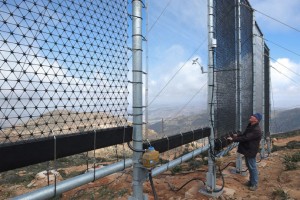The New Yorker
by Pauls Toutonghi

In the Moroccan desert, a series of black polymer nets can, in twenty-four hours, collect up to seventeen gallons of water—condensed fog from the nearby Atlantic—per square yard of netting.
“There are few places where life is so harsh,” Pablo Neruda wrote, describing his native Chile’s Atacama Desert. “It takes untold sacrifices to transport water there, to nurse a plant that yields even the humblest flower, to raise a dog, a rabbit, a pig.”
The Atacama is famously dry, receiving, in some areas, only a few hundredths of an inch of rain per year. In order to subsist in this environment, indigenous animal species such as the guanaco—a wild relative of the llama—have developed a range of innovative strategies. When the great banks of sea fog known as the camanchacas
sweep in off the Pacific Ocean, for example, the guanaco drink, very gingerly, the resulting condensation from the spines and flowers of the Echinopsis deserticola cactus. It is a remarkable act of survival in an inhospitable landscape.
March 22nd marks the twenty-third annual observance of World Water Day, an initiative overseen by U.N.-Water, which bills itself as “the United Nations inter-agency mechanism on all freshwater related issues.” It also marks the first anniversary of an ambitious international collaboration between Dar Si Hmad, a Moroccan N.G.O., and several German partner organizations to bring potable water to the Aït Baâmrane tribal region of southwest Morocco using a technology called CloudFisher. Aït Baâmrane borders the Western Sahara; like the Atacama, it is an area marked by centuries of desertification.
CloudFisher does exactly what it says on the tin. On the slopes of Mt. Boutmezguida, in the Anti-Atlas range, the project’s organizers have erected a series of tall steel poles, hung with rectangular black polymer nets. These are the fog harvesters. They look like the flags of long-buried pirate ships, standing out from the slope of the mountain, the only man-made thing for miles around, but they behave rather like Echinopsis cacti. Built on arid, rocky ground at an elevation of more than four thousand feet, they can, in twenty-four hours, collect up to seventeen gallons of water—condensed fog from the nearby Atlantic—per square yard of netting.
Reliable access to freshwater would, of course, provide a host of benefits to rural, water-poor districts in North Africa. According to the World Health Organization, a community requires about twenty gallons of water per person per day in order for its residents and their crops and livestock to thrive. Even a relatively small CloudFisher installation could provide a consistent water source for a group of rural families or a village. In a part of the world that is battling the progressive effects of continuous drought—exhaustion of wells, topsoil erosion, population loss as the land becomes inhospitable to agriculture—fog-water collection could be a life-altering adaptation.
The greatest benefit of the technology, though, might be time. In arid regions around the world, the task of obtaining water for the family frequently falls to women. Residents of Morocco’s rural villages commonly spend as much as four hours a day walking to and from functioning wells. The lucky families own or borrow donkeys, but often the women simply carry the barrels—five gallons each, weighing nearly fifty pounds—on their heads. In Africa alone, women spend an estimated forty billion hours a year fetching water.
Last March, at CloudFisher’s opening ceremony, the entire community gathered in two large tents, one for the men and another for the women. Morocco’s king, Mohammed VI, had sent a representative—not the regional governor, whose father had died the previous day, but the governor’s second in command, a man who was rumored to be high up in the line of succession to the throne. “Vive le roi!” the crowd chanted as he climbed out of his pristine white Land Rover, emblazoned on the side with “ROYAUME DU MAROC.” There were speeches in French, Spanish, German, Maghrebi Arabic, and Tashelhit, the local dialect.
The crowd crammed into the home of a local resident, and then, for the first time ever, the tap went on. There was a spontaneous cheer. Someone filled a ceremonial crystal goblet, which began to pass from hand to hand. Everyone drank the cold, pure fog water, known in French as “l’eau du brouillard.” After the ceremony, Jamila Bargach, the co-founder and director of Dar Si Hmad, was exultant. “On days like today, I am the queen of fog,” she said. “That’s how it is on the best days, anyway. On the worst days, I am its slave.”
Slave or queen, or a little of both. One year on, Bargach’s experience administering the program has been rich and complex. “With fog water flowing into these households, the transformation has been profound,” she said. “But it hasn’t been simple.” Dar Si Hmad has battled concern among the villagers that, because the water does not pass through the ground, it has no mineral content, and thus no life. Water that is not living is seen as unfit for religious ritual or, more important, human consumption. Bargach mentioned one particularly strong early opponent of the development project, a fifty-two-year-old grandmother named Fadma. “Her archenemy was fog,” Bargach said. “It was a state in between states. It was indeterminate and denoted too much haziness. But now it is redeemed in her mind. It is a fully standing, legitimate water source. And her granddaughters will have a different life experience than she did. They are now going regularly to school.”
But some women have struggled. Removed from their position of authority within the household—removed from the one thing that they could control with certainty—they have noticed a concomitant loss of domestic power. To combat this, Dar Si Hmad has scrambled to create a water school—to establish, around the management of this resource, a culture of conservation and sustainability. Related efforts have, in some cases, included basic literacy and numeracy training, because how can you report a broken pipe (and a grave threat to the clay wall of your house) if you can’t read the numbers on the front of a mobile phone?
As Dar Si Hmad has reckoned with the cultural implications of fog harvesting, the technology itself has evolved. While the basic science at its heart is not new—Bartolomé de las Casas mentions it in his sixteenth-century magnum opus, “History of the Indies”—the advancement of the harvesting equipment, in recent years, has been significant. “By changing the size of the holes, and the size of the fibres, and thinking about the coating on those fibres, we’ve improved the fog-collecting efficiency by about five hundred per cent,” Gareth McKinley, a professor of teaching innovation at M.I.T.’s School of Engineering, has said. The nets in Morocco, their designers say, are more durable and easier for locals to repair than similar nets built in the nineteen-nineties and early two-thousands in Eritrea, Chile, and Yemen.
With aquifer depletion worsening in North Africa, and in many other coastal regions around the world, including central California, the necessity of alternative water sources cannot be overstated. Even with conservation, the demands of the world’s population for freshwater will continue to grow. Arid regions are desperate for a solution. Saudi Arabia, for example, recently completed Ras al-Khair, a 7.2-billion-dollar desalination plant on the Persian Gulf. A towering behemoth that covers mile after mile of oceanfront real estate, Ras al-Khair pumps more than two million gallons of freshwater to Riyadh each day.
Yet, for all this expenditure, water remains an element—a mysterious and unpredictable essence, a deity that is prayed to, cursed, contemplated. “I do not know much about gods; but I think that the river / is a strong brown god,” T. S. Eliot wrote, in “The Dry Salvages.” Or, as Bargach put it, “Water is real hardship. But water is also gold.”





